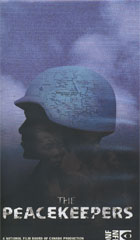
Peacekeepers 2005
Distributed by National Film Board of Canada, 1123 Broadway, Suite 307, New York, NY 10010; 800-542-2164
Produced by The National Film Board of Canada in co-production with 13 Production and ARTE France
Directed by Paul Cowan
VHS, color, 83 min. in English and French with English subtitles
College - Adult
African Studies, International Relations, Human Rights, Political Science
Date Entered: 06/02/2006
Reviewed by Maureen Puffer-Rothenberg, Valdosta State University, Valdosta, GAThe Peacekeepers shows the United Nations and its member states struggling to answer the question: “What is the worth of one failed African state?” The film focuses on the efforts of the United Nations Department of Peacekeeping Operations to stabilize the Democratic Republic of Congo (DRC), after five years of civil war had left the country in chaos.
In 2003 three million Congolese were dead, while a 2002 peace agreement and a supposed transitional government under the control of President Joseph Kabila had failed to unify the country. The eastern Congo, particularly the region of Ituri, is ruled by violent warlords and their child armies, fighting for control of Ituri’s gold and diamonds. When the UN sends investigators to determine which faction is responsible for a village massacre, a young girl is killed and mutilated to send a message that the warlords will not be intimidated by UN scrutiny.
UN investigators and observers are protected by Ugandan troops, who keep the warlords under control to a degree but may also be helping them. UN officials try to persuade developing countries to send troops into Ituri, but political and economic considerations override peacekeeping and human rights issues. Eventually 5000 Ugandan troops pull out of Ituri and are replaced by 750 less experienced Uruguayan soldiers. Congolese warlords challenge the peacekeeping forces and Ituri becomes a war zone; civilians flee their homes, trying to camp near centers of Uruguayan or UN command, and in May 2003 two UN military observers are killed. Shortly thereafter French soldiers enter Ituri to disarm the warlords, but France will commit its troops for only a limited time.
The Peacekeepers traces these developments in the Congo and follows Meg Carey, the UN’s Principal Officer of the Africa Division of the Department of Peacekeeping Operations, as she travels to Ituri to talk with local officials about stabilizing the area. Without elected officials, a police force, schools or a health system, the Congo has no foundation upon which to establish a peaceful society. The United States might shoulder the financial burden of such a project, but U.S. officials are reluctant to commit resources unless there is a plan in place for the withdrawal of troops, followed by Congolese peace and independence. Officials fear a massacre like the Rwandan genocide of 1994, or an unending civil war like that in Somalia.
This is a professional production incorporating location footage from the Congo and Ituri with meetings at the UN and interviews with UN officials. An effective, low-key narration helps to explain the political situation and UN Peacekeeping Operations strategies. Although somewhat lengthy and dry, the film accurately presents the intricacies and frustrations of international politics and the process of creating peace. Viewers should be advised that the film contains scenes of mutilated bodies, including that of a child killed with a machete.
The Peacekeepers is effective in showing the complexities of establishing peace in developing countries. This film would provide excellent support to college-level programs studying the Congo’s recent history or peacekeeping efforts of the United Nations and its member states.
Awards
- Vaclav Havel Special Award for the film with the most significant contribution to human rights awareness, One World International Human Rights Film Festival
- Honorable Mention, Category: Social Issues, Columbus International Film and Video Festival